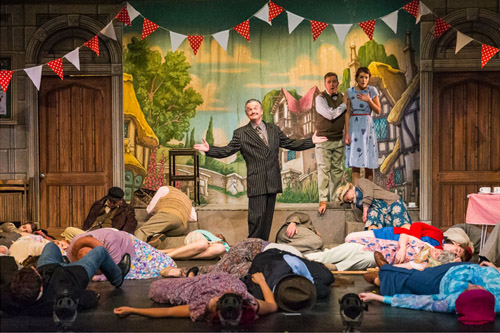 United Kingdom Gilbert & Sullivan – Trial by Jury and The Sorcerer: Soloists of the National Gilbert and Sullivan Opera Company, National Festival Orchestra / James Hendry (conductor). Royal Hall, Harrogate, Yorkshire, 19.8.2018. (RJW)
United Kingdom Gilbert & Sullivan – Trial by Jury and The Sorcerer: Soloists of the National Gilbert and Sullivan Opera Company, National Festival Orchestra / James Hendry (conductor). Royal Hall, Harrogate, Yorkshire, 19.8.2018. (RJW)

Trial by Jury
Production:
Director — Ian G Smith
Lighting Design — David Marsden
Wardrobe — David Morgan
Scenic Designer — Paul Lazell
Cast:
The Learned Judge — Richard Gauntlett
The Plaintiff (Angelina) — Ellen Angharad Williams
The Defendant — Nicholas Sales
Counsel for the Plaintiff — Matthew Kellett
Usher — Stephen Godward
Foreman of the Jury — Tim Southgate
Associate — Neil Smith
First Bridesmaid — Emma Watkinson
Fantastic! I’d like to have been able to preserve this performance in aspic.
It may say something of my conditioning, but more that with excellent singing and musical accompaniment the balance between characters and flow of action is perfect, and I don’t see how it could be bettered. Presenting the piece in a traditional Victorian format shows that modern novelty or new interpretation is unnecessary if brought ‘up to date’. From its powerful chorus opening the show had everyone sitting up from the start. The superb singing coupled with intelligible diction made the reception most pleasing. Fresh elements were introduced by having individual characters for the jury and public gallery that brought many a smile and were fascinating to study; they were accurately dressed in muted colours to represent different strata of London society. This made good contrast with the splash of brightness and colour with the entrance of pink dressed bridesmaids and the white of the jilted bride, Angelina. Particularly effective was the Usher (with eccentric wig) who used his staff to control the sloppy jury and make lift of their arms high enough for praise during the Judge’s entrance or kneel low enough for piety. Angelina was sufficiently flirty and the Judge reacted to this with good comedy. Edwin managed to shun her irritating advances and attach himself to the charm of the First Bridesmaid.
The highlight in any production of Trial is undoubtedly the Bellini take-off in ‘A nice Dilemma’. This was achieved with much panache under James Hendry’s direction. Throughout, the Festival Orchestra was a delight to listen to.
The Sorcerer

Production
Director — John Savournin
Choreographer — Damian Czarnecki
Lighting Design — David Marsden
Wardrobe — David Morgan
Scenic Designer — Paul Lazell
Cast included:
Sir Marmaduke — Eddie Wade
Alexis — Nicholas Sales
Dr Daly — Matthew Kellett
Notary — Stephen Godward
John Wellington Wells — Richard Gauntlett
Lady Sangazure — Mae Heydorn
Aline — Ellen Angharad Williams
Constance — Emma Watkinson
Hercules — Henry Smith
To contrast with the above, the professional singer/director, John Savournin, has put together a new modern version of this early Gilbert & Sullivan opera. Having considerable experience and success with his interpretation of The Pirates of Penzance and other operas it was with much interest that the audience came to see this particular production.
Set in the 1960s, the village hall of Ploverleigh was our setting, with upright piano and appropriate village stereotypes. A village choir is discovered singing to pseudo piano accompaniment (yet with full orchestral backing) after which there are the usual Gilbertian comings and goings. The scene with a lovesick Constance (Emma Watkinson) propped up by her mother when she swoons over their pastor, Dr Daly (Matthew Kellett), is acted convincingly and works brilliantly. Mrs Partlet (Ros Griffiths) brought a new dimension to the part with her strong mezzo voice and pushy stage business. Richard Gauntlett as John Wellington Wells did not disappoint with his ‘Spiv’ persona, Cockney accent and clear audibility. Nick Sales made a good Alexis without the hang-ups sometimes found in productions and handled the self-inflicted confusion in a believable way. His ‘Thou hast the Power’ was superbly delivered and a highlight to the show. Ellen Angharad Williams made a delightful Aline (as she was Angelina earlier) and partnered Alexis ideally with her wide range and strength of voice. Perhaps a disappointment was the incantation scene, which to me seemed to cry out for low level, more effective directional lighting and the tea urn’s spell delivered closer to the flash boxes downstage; association of magical elements seems important.
A nice touch is for the Act II finale to copy the Act I tea party that goes disastrously wrong. In Act II the tea served to the company is now uncontaminated and they conclude by cheering the audience with raised tea cups — a simple but nice parallel. The scene where the villagers awake with new partners after taking the love potion was convincing and I felt that Savournin’s direction of having Aline fall asleep on stage during Daly’s monologue made more sense than the traditional D’Oyly Carte direction of going off-stage, since sleep is an important element in activating the potion’s effect. Much was made of the mediocre comedy found in Gilbert’s book and so the performance fulfilled the audience’s needs.
It was necessary for the scenery to be a compromise since it has to double up for both productions; when set as the village hall it looks reasonably convincing apart from an upstage platform area where much activity by Wells takes place. Beyond is seen a quirky village street scene that seems more appropriate to pantomime perhaps.
As with Trial, the cast was good and sang the show’s charming ballads with perfection. James Hendry brought out some often-hidden detail in the music to add to the joy of the performance and the playing was delivered at an energetically brisk pace. However, I was not convinced that Dr Daly’s recitative to Sullivan’s early English setting worked with modern dress and so might have been better delivered as dialogue.
Raymond J Walker